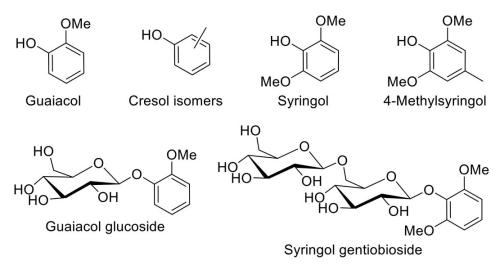Smoke has long been used to flavour and preserve foods, and products with smoky characters – meat, seafood, cheese, spices, nuts and Scotch whisky – are still enjoyed today.
Similar characteristics in wine are not always pleasant. “Smoky” and “spicy” traits, among others, end up in wine when wines are stored in oak barrels for periods of time. These smoky traits are due to volatile phenols (VPs), which are lignin pyrolysis products extracted from toasted or charred oak. Oak sensory traits are desirable and generally improve the quality of wine. But “smoke taint”, caused by bushfire (wildfire) smoke in the vicinity of vineyards, has a catastrophic effect on fruit and wine quality, and results in hundreds of million dollars in lost revenue for the Australian wine industry. This is now a significant global issue. With a changing climate, the incidence of bushfires is increasing, not only in hot and dry winegrowing regions of Australia but also in the US, Canada, Chile, France and South Africa.
We have worked on aspects of smoke taint for well over a decade and have an active Linkage Project on the topic. Some of that work is described here, but there is still more to be done.
The phenomena surrounding smoke taint in wine is complex – various VPs in smoke are absorbed by the grape and glycosylated at the phenolic hydroxyl group, leading to “bound” forms (Fig. 1) that can no longer be sensed by smell. This was first shown by a novel isotope tracer study whereby deuterated guaiacol was applied externally to grape bunches and leaves, with deuterated guaiacol glycosides subsequently being identified in extracts by high-performance liquid chromatography tandem mass spectrometry.
Further work involved the synthesis of deuterated phenols and their glycosides (including diglycosides containing glucose linked to another sugar) as standards, and analytical method development. Phenol glycosides are now routinely used as marker compounds for smoke taint diagnostics, along with the free VPs (to a lesser extent due to their presence in oak-matured wines). However, as with other bound flavour precursors in grapes, such as monoterpenoids and C13-norisoprenoids, enzymatic activity during fermentation and the acidic pH of wine can release the VPs again, as can oral microflora upon tasting wine containing the glycosides. Thus, the presence of phenol glycosides in grapes – at the levels seen with smoke-tainted fruit – is problematic for producers, and an effective management or remediation strategy for smoke-tainted wine remains elusive.
Some recent and current work is aimed at developing remediation or prevention strategies – from protective coatings in the vineyard to winemaking practices – while still trying to understand VP uptake and glycosylation in the grape berry, and identifying potential new smoke taint marker compounds. With respect to the latter, volatile thiophenols have been proposed to act in concert with their VP analogues. As with other compounds containing a thiol group, the sensory detection thresholds of thiophenols (i.e. the concentration at which a proportion of the population could perceive a difference) are orders of magnitude lower than the VPs themselves, meaning that ultratrace quantities can have a significant sensory effect. The broad relevance of thiophenols to smoke taint is, however, an open question, as is their origin.
A promising amelioration strategy for tainted fruit involves the novel use of a spinning cone column for low-temperature distillation (also used for wine de-alcoholisation). This introduces a physical chemistry aspect, along with the synthetic and analytical tools mentioned earlier. Spinning cone column treatment of wine revealed only minor amounts of VPs found in the condensate (which contains ethanol and aroma compounds), so that they were concentrated in the treated wine – by up to 63% in the case of guaiacol at the highest strip rate. This was not the desired scenario because the smoke taint characters were exacerbated in the stripped wine, although future work could look at removing those VPs before reintroducing the ethanol and aroma-rich distillate fraction.
In contrast, treatment of juice revealed the opposite – VPs were distilled over and found in the condensate, probably as a result of a salting out effect due to the high concentration of sugar in the juice. This outcome is advantageous because many wine aromas are not present in juice but are formed during fermentation. In this case, the condensate (after passage through an ion exchange resin) was blended with the treated juice and fermented, with the resulting red wine having lower VP concentrations than the original juice (60% in the case of guaiacol and complete elimination of several other VPs). Curiously, syringol concentrations were increased in the resultant wine, which could be explained by hydrolysis of syringol gentiobioside (or other precursors) present in the juice.
More research is still required, including into the nature of the aglycones, to fully understand the chemical phenomena associated with smoke-tainted wine, but strong progress has been made since the issue first arose some 20 years ago.



